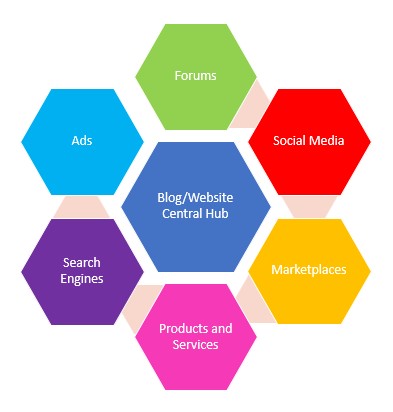Last week's post was about factors to consider when selecting the right products and services for your business.
Today we will walk through how to select a selling platform that's right for your business. Use the table of contents below to navigate to the areas of the page that interests you most. If you're short on time, watch the video.
Update: This post, was originally posted 2/28/21. It has been updated as of 05/03/25.
Since each business is different, the requirements for the platform you choose might be totally different than your neighbor's.
No matter what products, services or business model you select, one thing is for sure. You will need a place for your online business to call home. A place you own and control that allows you to sell products and earn money.
This article will show you the primary platforms that will help you highlight your products and services, and grow an audience with affordable tools that are easy to use.
Free Video Training
Grab a cup of coffee or your favorite drink, and watch the video training to learn about the choices you have when it comes to choosing an online platform. You'll also learn about free platforms and why (if possible) it makes sense to select a platform that does the heavy lifting to earn more money.
Platforms Mentioned in the Video
What is a Selling Platform?
Last week, we talked about people who avoided starting an online business (they specifically hated selling) like the plague.
They would rather have a tooth pulled (without numbing) than walk up to a complete stranger and ask them to take a look at their product or service. I totally get it.
This post will talk about building a platform that does the talking, selling and following up (what I like to call the heavy lifting) for you. One that sorts through visitors and gives them the information they are looking for. One that attracts the right audience, and promotes, presents, educates and sells 24/7.
As a business owner, you need a place to send your visitors, followers and customers to learn more about how you can help them, one that shows them everything you have to offer.
How to Select a Selling Platform for Your Business
Let's start with a definition of the phrase "selling platform".
A selling platform is defined as a digital space that allows users to sell products or services to a wide audience.
A platform is defined as a raised floor or stage for performers or speakers
For me, a selling platform is a place to send readers, followers and visitors to learn more about the help I can give them. That help may take the form of an article that helps them make a buying decision, a product or service that helps them reach their goals.
Let's talk about the most popular online platforms for getting your business online.
What to Consider When Selecting a Platform for Your Business

When you select a platform for your business you should consider how well the platform does the following:
Here are three types of online platforms that you should research to build your business. These are the primary players, and your audience will recognize these as legitimate, safe places to go when they are looking for information. You can always venture out to other platforms once you've mastered these.
How to Use "Limited Use" Platforms
There are different kinds of platforms with different purposes. For example, there are platforms you can use to share your content. It's important to note the differences between the platform you call home on the Internet and the places where you distribute your content.
Platforms and communities like Beacons.ai, Tumblr, Etsy, Medium, Quora, Twitter, Instagram, Facebook, Linkedin, Soup.io, etc., are great places to share your content with the masses. But these platforms are not designed to serve as your primary platform or as a home base for your business.
Don't get me wrong... Using these platforms to promote and network can help to get your business off to a great start, sending targeted traffic to your primary platform, versus struggling to find an audience because you don't know where or how to promote your content.
However, for your primary platform, you need a place that allows you to brand your business, position yourself as an authority in your niche and add functionality and automation that does the heavy lifting for you 24/7.
You might think the platforms mentioned above can handle everything you need... until you need to generate leads, build a list, create a landing page, or gather sales and marketing data.
The biggest downfall of relying on platforms like the ones mentioned above, is that you don't own or control them. Which means they can shut you down, hide your content (also called ghosting) at any time they feel like it.
Especially if you break their rules or violate their terms that are subject to change at any time.
Open an Etsy Store!
Discover how to open your shop, optimize your listings, getting your products online with 40 free listings.
A Self Hosted WordPress Platform
Using a self-hosted WordPress tool offers numerous benefits for website owners. Here are some key advantages:
1. Complete Control: With a self-hosted WordPress site, you have full control over your website, including the design, functionality, and content. You can customize your site to meet your exact needs without restrictions.
2. Unlimited Customization: You can choose from thousands of themes and plugins to extend the functionality of your site. Whether you need an e-commerce store, a blog, or a portfolio, you can build it with WordPress.
3. Enhanced Security: You can implement your own security measures, such as choosing secure hosting, installing security plugins, and regularly updating your site to protect against vulnerabilities.
4. SEO Optimization: WordPress is SEO-friendly out of the box, and you can further optimize your site using various plugins and techniques to improve your search engine rankings.
5. Scalability: A self-hosted WordPress site can grow with your business. You can start small and expand as needed, adding new features and content without limitations.
6. Monetization Options: You have the freedom to monetize your site in any way you choose, such as displaying ads, selling products, offering memberships, or creating online courses.
7. Ownership of Content: You own all the content you create on your site. This is important for branding and intellectual property reasons, as you are not bound by the terms and conditions of third-party platforms.
8. Community and Support: WordPress has a large and active community of developers and users. You can find support through forums, tutorials, and documentation, making it easier to troubleshoot issues and learn new skills.
9. Integration Capabilities: WordPress integrates with a wide range of third-party services and tools, including social media platforms, email marketing services, payment gateways, and more, enabling seamless operations.
10. Cost-Effective: While there are costs associated with hosting and premium plugins/themes, using WordPress can be more cost-effective in the long run compared to other website builders, especially for larger or more complex sites.
By choosing a self-hosted WordPress solution, you can create a robust, flexible, and personalized website that grows with your business needs.

Start a WordPress Blog
Create a sales and marketing system that works 24/7 to convert visitors into engaged customers.
Choose a Self Hosted Shopify Store as Your Selling Platform
Using Shopify offers many benefits for entrepreneurs looking to create and manage an online store. Here are some of the key advantages:
1. Ease of Use: Shopify is designed for users of all technical skill levels. Its user-friendly interface and drag-and-drop functionality make it easy to set up and manage your store without needing extensive coding knowledge.
2. Quick Setup: With Shopify, you can quickly launch your online store. The platform provides a streamlined setup process with clear instructions, allowing you to get your store up and running in no time.
3. Customizable Themes: Shopify offers a wide range of professional and customizable themes. You can choose a theme that fits your brand and customize it to create a unique and visually appealing storefront.
4. Mobile Optimization: All Shopify themes are mobile-responsive, ensuring that your store looks great and functions well on any device, which is crucial for reaching customers who shop on their phones or tablets.
5. App Integrations: Shopify has a vast app store with thousands of apps and plugins to extend the functionality of your store. You can add features like advanced analytics, email marketing, social media integration, and more.
6. Secure and Reliable: Shopify provides secure hosting, ensuring that your store is protected from cyber threats. It also handles PCI compliance, giving you and your customers peace of mind when it comes to payment security.
7. 24/7 Support: Shopify offers around-the-clock customer support via phone, email, and live chat. This ensures that you can get help whenever you need it, whether you're facing a technical issue or need advice on growing your store.
8. Built-in Payment Processing: Shopify Payments allows you to accept credit card payments directly through your store without needing to set up a third-party payment gateway. This simplifies the checkout process for your customers.
9. SEO and Marketing Tools: Shopify includes built-in SEO features to help improve your store's visibility in search engines. It also offers marketing tools like discount codes, gift cards, and social media integration to help you attract and retain customers.
10. Scalability: Shopify can scale with your business as it grows. Whether you're a small startup or a large enterprise, Shopify provides the tools and resources to support your growth, including options for high-volume merchants.
11. Multichannel Selling: Shopify enables you to sell on multiple channels, including online, in-person, through social media, and on marketplaces like Amazon and eBay. This helps you reach a broader audience and increase sales.
12. Global Reach: Shopify supports multiple languages and currencies, making it easier to sell to customers around the world. You can also take advantage of international shipping options to expand your market.
Overall, Shopify provides a comprehensive and flexible e-commerce platform that can meet the needs of a wide range of businesses. Its ease of use, extensive features, and strong support make it a popular choice for online entrepreneurs.

Bring your ideas to life and Get Started with Shopify
The future of business is yours to shape. Sign up for a free trial and enjoy your first month for just $1.
WooCommerce a Free, Open Source, WordPress eCommerce Solution
Using WooCommerce, a free, popular WordPress plugin, for your e-commerce site offers several benefits:
1. Full Customization: WooCommerce provides extensive customization options. You can tailor your online store to your specific needs using themes and plugins, allowing you to create a unique shopping experience.
2. Integration with WordPress: As a WordPress plugin, WooCommerce integrates seamlessly with your WordPress site. This allows you to leverage the power of WordPress's CMS capabilities alongside your e-commerce functionalities.
3. Cost-Effective: WooCommerce is free to use, with no monthly fees. While there may be costs associated with hosting, themes, and additional plugins, it can be a more affordable option compared to other e-commerce platforms.
4. Scalability: WooCommerce can grow with your business. You can start small and add new features and products as your business expands without significant constraints.
5. Extensive Plugin Library: WooCommerce has a vast library of plugins and extensions that can enhance your store's functionality. Whether you need advanced analytics, marketing tools, or payment gateways, there's likely a plugin available.
6. SEO-Friendly: WooCommerce is built on WordPress, which is known for its strong SEO capabilities. This helps your products rank better in search engine results, driving more organic traffic to your store.
7. Control Over Data: With WooCommerce, you have full control over your data. Unlike some hosted platforms, you own your data and can export it whenever needed.
8. Community Support: WooCommerce has a large, active community of users and developers. You can find extensive documentation, tutorials, forums, and support to help you troubleshoot issues and improve your store.
9. Multiple Payment Gateways: WooCommerce supports a wide range of payment gateways, including PayPal, Stripe, and many others. This provides flexibility for you and convenience for your customers.
10. Product Variability: WooCommerce allows you to create and manage a variety of product types, including physical, digital, and subscription-based products. You can also offer product variations such as size, color, and more.
11. Shipping Options: WooCommerce provides flexible shipping options, including flat rates, international shipping, and local delivery. You can also integrate with various shipping carriers for real-time rates and tracking.
12. Security: WooCommerce is regularly updated to address security vulnerabilities. Additionally, you can enhance security through various plugins and best practices, such as SSL certificates and secure payment gateways.
13. Analytics and Reporting: WooCommerce offers built-in analytics and reporting tools to help you track sales, view customer data, and monitor overall store performance. You can also integrate with Google Analytics for more advanced insights.
14. Multilingual and Multi-Currency Support: WooCommerce supports multiple languages and currencies, making it easier to reach and serve a global customer base.
15. Mobile-Friendly: WooCommerce themes are typically responsive, ensuring that your store looks great and functions well on mobile devices, which is essential for modern shoppers.
By choosing WooCommerce, you can create a highly customizable, scalable, and cost-effective online store that meets your specific business needs while benefiting from the powerful features and flexibility of WordPress.
Download the WooCommerce Plugin
The WordPress-based eCommerce platform helps merchants and developers build successful businesses for the long term.
Video - YouTube, Vimeo and Others
Videos are one of the best ways to reach your audience, and build the know, like and trust factor. The reason is that most people love to watch videos. It's a great way to get your message across quickly, building trust and credibility.
When you choose YouTube as your online platform, you are choosing the 2nd largest search engine on the internet. That increases your chances of building an audience that is looking for what you have to offer.
YouTube is great for branding and showing your personality, style and approach. YouTube can help prospective clients decide whether they want to set up an in person meeting or buy your products.
It allows you to show your expertise with demos, lives and more. It's also a great option to blogging if you hate writing.
I also have a video that shows a work around to actually writing your articles if you hate writing. Check the video out here.
TubeBuddy
Optimize your YouTube videos and grow your channel with SEO and AI tools.
YouTube Has Low Start Up Costs
There is low start up with YouTube, because the only steps you need to take are (1) sign up for a free Gmail account, (2) and start a YouTube channel for free.
To create your channel art, go to Canva, and set up a free or paid account. Once your account is set up, search for YouTube Channel Art.
There are lots of templates, fonts, graphic elements and photos you can access even with the free account to design amazing artwork for your channel. Then upload it to YouTube. You can check out the image I used for my channel below.
You don't need a huge budget for equipment either. You can use the equipment that comes with most laptops, desktops, tables and cell phones to make videos.
All of these devices come with a basic microphone, camera, and video camera installed. If you have a minimal budget, these pieces of equipment will get you started.
You also need a place in your home to make your videos. An area that is free of noises and distractions.
How to Get Started on YouTube
First read our article on the best way to start a YouTube channel. for a step by step tutorial that shows you how to optimize your videos so that they rank not only on YouTube but Google as well. You also learn the best way to set up your channel.
Next create a strategy for your channel that will help you get off to a great start. For example, a video series is a good way to jump start your channel. What are some of the questions you receive from your customers? What problems can you help them solve? Is there any foundational information that will help potential customers do business with you? Try to start your channel with helpful information (tips, tools, how-to's) versus trying to sell something. That will come later.
Once you've established a good amount of helpful videos, you can start adding short blurbs on your videos about related products and services at the middle or end of your videos and link to more information in the transcripts.
Once your channel is established with a certain number of subscribers, you can go full speed to monetize it and start earning from YouTube ads.
You know, those irritating ads that come on in the beginning and middle of YouTube videos? You can become of of "those" people :-0... just kidding.
You'll still want to balance selling to about 20% of your content and adding helpful, valuable information to about 80%. The goal is to be the resource your audience relies on to help them solve their issues and provide bright, helpful, new ideas.
Another way to monetize your videos is by becoming an affiliate and mentioning any complimentary or related affiliate products or services in your videos.
You can also provide product review videos to drive traffic and make affiliate sales. Make sure to disclose that you have a relationship with the sponsor in your video and in your transcript.
Video Resources:
Here are my affiliate links to the optional and affordable software and equipment I use for my videos:
1. Blue Snowball Microphone: This mic has a custom condenser capsule that offers crystal clear audio for Skype, Messages and FaceTime. Record vocals, create podcasts, and add narration to your home movies. YouTube; Frequency Response: 40 –18 kHz. Plug and play directly to your Mac or PC—no drivers to install. A USB 2.0 device (USB 3.0 compatible as per USB 3.0 backward compatibility specification).
2. Add another screen affordably with the HP V20 HD 19.5-inch Monitor: Adding another screen will help you view your content while providing online presentations and training. The HP V20 is the quintessential, everyday monitor that adjusts to your needs, saves space, and doesn’t break the bank.
3. Webcam with Microphone, 1080P HD Streaming: This computer webcam can plug and play very easily. with a USB 2.0 connector. There's no need to download or install any complicated driver software. 3D denoising webcam with microphone: Built-in 8m omnidirectional sound absorption and noise reduction microphone. Picks up your voice and filters out background noise automatically, enabling you to enjoy clearer voice for hassle-free communication.
Record up to 10 minutes per Video with BandiCam Free Video Screen Sharing Software
Unlimited Recording with BandiCam Paid Video Screen Sharing
6. StreamYard for Live Video Streaming: StreamYard is a live streaming studio in your browser. Interview guests, share your screen, and much more. Stream directly to Facebook, YouTube, LinkedIn, and other platforms.

Podcasting to Grow Your Audience
Podcasting has become a popular way to get your messages to more people. When you podcast, you use a talk radio format to reach and grow your audience.
The goal is to provide tips, advice, motivation, ideas and information your listeners can use to make their lives better.
A podcast can be used with a video channel and blog to give your audience content in the way that helps them consume it best.
Listen to a recent episode of our podcast below. We embed episodes on our blog and post on social media when we publish a new content.
We also have a page that showcases our podcast right here on our blog. Check it out for business building tips you can receive on the go! Follow our podcast wherever you listen to podcasts.
We use Spotify for Podcasters (formerly Anchor.fm) as our podcasting platform. We use the same equipment to record our podcast that we use for making videos. We have even recorded our episodes using our iPhone.
For example, some people are visual so watching a video might be best.
Others like to listen to content because they absorb it better in that format. They can listen while driving, working out, cleaning the house, or cutting the grass.
Still others love to read because they learn better when they see information written out.
Podcasting also shows your personality and style to your audience. This platform can be monetized in the same way as video platforms.
You can work with sponsors if you have a large audience, or you can mention your affiliate offers or lead your audience to your blog or YouTube channel for more information on your affiliate offers.
Here are a few interesting statistics about Podcasts as of 2021:
Once your podcast has been uploaded, you want it to be distributed. You'll want a host that will distribute your podcast to places like: Pandora, Spotify, iHeartRadio, Apple Music, Amazon Music, SoundCloud, and Google Play All Access.
This means more visibility for your content. Once you have started distributing your content on these sites, you're not just limited to standard social media sites.
Here are a few tips for giving people the best experience when listening to your podcast:
- Create interesting content, which means editing out a lot of the opening chit chat, off-topic tangents or long pauses while a guest thinks.
- Have one CTA or topic per episode so you don't overwhelm or confuse your audience.
- Be concise and sum up key points for your listeners, because it's not that easy to rewind a podcast episode (particularly with smart speakers).
- Make it super easy to listen to your podcast – in other words, don't require a sign-up, download or any other hoops to jump through just to listen to an episode.
Low Start Up Costs
Starting a podcast is very inexpensive for those on a shoestring budget. As with video recording, you can use the equipment that came with your device to get started.
Since you're not showing anything visually, it might be a good idea to invest in an affordable, higher quality microphone.
I purchased my Blue Snowball microphone for about $70 and it does a great job of cutting out the hiss, I was getting from y laptop and any background noise that might occur while I'm recording. I also covered it to filter out noise.
Podcasting Resources:
I use the resources mentioned in my Video Resources List for my podcast plus the hosting provider below. You can use my referral link and get a free $20 Amazon gift card when you pay for Buzzsprout podcast hosting!
7. BuzzSprout for Podcast Hosting: The best way to host, promote, and track your podcast. Free for 90-days! World class support. No contracts. Connect on any device. No credit card required.
Blogging: A Platform You Own and Control
You've probably heard me say this a million times. You own and control a self hosted WordPress blog. And that means a lot. Of the three platforms I've talked about, this one is the only one that can make that claim.
The other platforms can be shut down if you break the terms of service provided by the platform. So if your videos break YouTube's policies, they can shut you down, no questions asked.
You can appeal it, but there is no guarantee that they will re-instate your content.
A blog is a place to send everyone (prospects, leads, followers, visitors, and customers) for your content, deals, lives and offers. The other platforms have limitations that don't apply to blogging.
There are free blogging platforms available, however they are platforms that provide you with no way to collect emails, no forms, no landing or sales pages, no countdown timers... no control.
A blog is a great place to monetize all your content. You can create an eCommerce site and sell things on a platform that you control. That means you control the cost, how much and how long it's offered.
Get your blog foundation set up in 15 minutes with our free Blogging Basics course with step by step video and written instructions.
Your Blog As Your Central Traffic Hub

You can drive traffic from these sources to your blog, using it as a central traffic hub.
Driving everything to a central location that gives you analytics data, will help you get a realistic view of the kinds of activities that will help your audience to grow.
Low Start Up Costs
You can start a blog for as little as $2.95 per month when you pay annually. You can also pay on a monthly basis for your hosting. We discuss these options in depth in our free Blogging Fundamentals course.
Resources
Themes and Site Builders
Email Marketing Providers
Payment Processors

Stay Tuned to Learn More
The goal of your platform should be to add value, generate leads, sell, educate, present and promote 24/7. It should also fit your goals and objectives.
The main take away from this post is that you can see how using all three of these platforms together will help you reach a much larger audience.
Stay tuned to our Facebook page for up to date information on tools and resources you can use to grow your online business.
Get Off to a Great Start with 4 Months of WP Engine Hosting for Free!

WP Engine is moving full speed ahead with 4 months FREE for WordPress on all annual shared hosting plans (Startup, Professional and Growth Plans) for a limited time. Even if you're on a non WordPress platform you can use their free WordPress migration plugin to convert your site to WordPress. This offer is valid for new customers.








